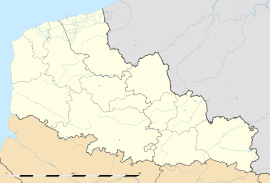Maubeuge
| Maubeuge | ||
|---|---|---|
 | ||
| ||
 Maubeuge | ||
|
Location within Nord-Pas-de-Calais region  Maubeuge | ||
| Coordinates: 50°16′39″N 3°58′24″E / 50.2775°N 03.9734°ECoordinates: 50°16′39″N 3°58′24″E / 50.2775°N 03.9734°E | ||
| Country | France | |
| Region | Nord-Pas-de-Calais | |
| Department | Nord | |
| Arrondissement | Avesnes-sur-Helpe | |
| Canton | Maubeuge-Nord and Maubeuge-Sud | |
| Intercommunality | Maubeuge Val de Sambre | |
| Government | ||
| • Mayor (2001–2008) | Rémi Pauvros | |
| Area | ||
| • Land1 | 18.85 km2 (7.28 sq mi) | |
| Population (1999) | ||
| • Population2 | 33,546 | |
| • Population2 Density | 1,800/km2 (4,600/sq mi) | |
| INSEE/Postal code | 59392 / 59600 | |
|
1 French Land Register data, which excludes lakes, ponds, glaciers > 1 km² (0.386 sq mi or 247 acres) and river estuaries. 2 Population without double counting: residents of multiple communes (e.g., students and military personnel) only counted once. | ||
Maubeuge is a commune in the Nord department in northern France.
It is situated on both banks of the Sambre (here canalized), 36 km (22 mi) east of Valenciennes and about 9 km (5.6 mi) from the Belgian border.
History
Maubeuge (ancient Malbodium, from Latin, derived from the Old Frankish name Malboden, meaning "assizes of Boden") owes its origin to Maubeuge Abbey, a double monastery, for men and women, founded in the 7th century by Saint Aldego, the relics of whom are preserved in the church. It subsequently belonged to the territory of Hainaut. It was burnt by Louis XI of France, by Francis I of France, and by Henry II of France, and was finally assigned to France by the Treaty of Nijmegen.
It was fortified by Vauban by the command of Louis XIV of France, who under Turenne first saw military service there.
Besieged in 1793 by Prince Josias of Coburg, it was relieved by the victory of Wattignies, which is commemorated by a monument in the town. It was unsuccessfully besieged in 1814, but was compelled to capitulate, after a vigorous resistance, in the Hundred Days.
As a fortress Maubeuge has an old enceinte of bastion trace which serves as the center of an important entrenched camp of 18 miles perimeter, constructed for the most part after the War of 1870, but since modernized and augmented.
The forts were besieged in World War I by the German Empire. Maubeuge suffered heavily in World War II: 90% of the town centre was destroyed by bombardments in May 1940. Fighting again occurred in 1944, in and around the outskirts of Maubeuge, involving units of the U.S. 1st Infantry Division during the American push toward Belgium.[2][3]
It became a source of humour (rather like Palmerston North in New Zealand through John Cleese) throughout France with Bourvil's satirical song "Un Clair de lune à Maubeuge".
Heraldry
 |
The arms of Maubeuge are blazoned : |
Economy
There are important foundries, forges and blast furnaces, together with manufactures of machine tools and porcelain.
The town has a board of trade arbitration, a communal college, a commercial and industrial school.
Tour de France
Maurice Garin, the winner of the inaugural 1903 Tour de France, began his cycling career in 1892 with the local Maubeuge cycling club, when he finished 5th in the Maubeuge-Hirson-Maubeuge, 200 kilometres (124 mi)race.[4] In 2003, on the 100th anniversary of his win, he was commemorated with a street named after him.
Personalities
- Leandre Griffit, football player
- Jan Gossaert, painter
See also
- Siege of Maubeuge (24 August–7 September 1914)
- Communes of the Nord department
Sources
- INSEE (English)
 This article incorporates text from a publication now in the public domain: Chisholm, Hugh, ed. (1911). Encyclopædia Britannica (11th ed.). Cambridge University Press
This article incorporates text from a publication now in the public domain: Chisholm, Hugh, ed. (1911). Encyclopædia Britannica (11th ed.). Cambridge University Press
Footnotes
External links
- Official website (in French)
- Webpage about the fortifications
| Wikimedia Commons has media related to Maubeuge. |